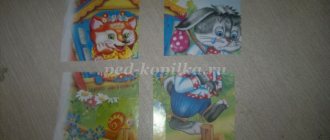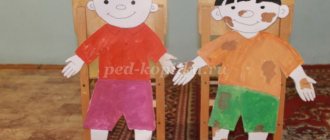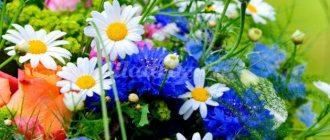MAGAZINE Preschooler.RF
Notes on communication (speech development) in the second junior group Topic: “Visiting Mishka” Examination of tea utensils Program content: Continue to introduce children to objects in their immediate environment - tea utensils and their purpose. Expand children's vocabulary through nouns (tea party, sugar bowl, napkin bowl), adjectives (tea, red, blue, yellow, green), details, qualities and properties. Teach children to answer the teacher’s questions by matching the words in a sentence. C Foster a caring attitude towards household items Integration of educational areas: communication, cognition, socialization, work, health, safety. Preliminary work: • Games in the doll corner • Examination of dishes in everyday life • Reading the work of K.I. Chukovsky “Fedorino Grief” Material: • Table • Tablecloth • Chairs for guests BearsContents of educational activities
1. Organizational moment Children sit in a semicircle in front of the table. There is a knock on the door. Educator: Children, who is knocking on our door, but won’t dare to enter? I'll go and have a look, and then I'll tell you all. Children, who is this? (shows Mishka) Look how handsome he is today. Bear, is it your holiday today? - Yes, guests will come to me. Please help me set the table, I want to treat them to tea. Guys, can we help our Mishka? 2. Main part: Didactic game: “What’s extra?” The teacher begins to set the table. Places on the table: cups, frying pan, saucepan. Children: -No. The pot and pan are superfluous. Educator: -Why is there no need for a saucepan on the table? Children: -They cook soup in it. Educator: -Why is there an extra frying pan? Children: - Meat, fish and cutlets are fried in it. Educator: - Children, please help me set the table for tea. 3 Game situation “Let’s set the table for tea” Children bring napkins, sugar, spoons. Educator: - where do we put the sugar? Children: - into the sugar bowl. Educator: - Correct. Special utensils for sugar - sugar bowl. And there is a special stand for napkins. I wonder who knows what it's called? (Napkin holder.) - Guys, cups, teapot, saucers, sugar bowl - all this is tea utensils - What is the saucer for? -Put a cup on it so as not to stain the tablecloth and put a spoon. Let's play with you. 4. Physical education lesson: One, two, three, four, We washed the dishes: Kettle, cup, ladle, spoon And a large ladle. This is how we helped mom! Educator: - Well done. Oh, what are we going to brew tea in? (in the kettle.) Educator: - That’s right, our kettle has boiled, only it’s hot. How are we going to drink it? What needs to be done to make the tea cool? (Blow on him.) 5. Breathing exercises Teacher: - okay, now we will blow (the teacher shows, the children do: sit up straight, bring the cup to your mouth, inhale through your nose, hold your breath, exhale through your mouth). . What are we going to treat Mishka to? (with tea) Yes, and that’s why they set the table with tea dishes. Name what dishes you put on the table? (pronounce utensils)
6 Listen to the poem: We have teaware on the table. Here is a large and yellow teapot, Very important as a boss. Here are the green cups, very fragile poor things. Here are the green saucers, only knocking will break. Here are the little white spoons, the head on a thin stem. Here is a plastic tray. He brought tea dishes!
Educator: - Well, we drank tea, how many dirty dishes are left! Where do we take it? Let's clean it up and wash it. 7. Summary “What did you learn?” What did we guys do in class? What new words did you learn? The bear treats children to candy and gives them coloring books.
| Next > |
"Let's help Eve the frog." GCD on communication in the second junior group
Program content:
- Form the pronunciation of the sound combination y'e in isolation, in words, syllables and phrases.
- Strengthen the pronunciation of the sound combination y'o, develop auditory perception.
- Practice modulating your voice by pitch.
Integration: communication, reading fiction, socialization, cognition, work, physical education, health, music.
Materials and equipment: Magnetic board, fir trees, magic box with images: apple, hedgehog, spruce, train, frog, squirrel, hoops, mask - heron, vitamins - fruits; illustrations for the poem: squirrel, nuts, fox, sparrow, titmouse, bear, bunny; drawings for the game “Listen carefully”: dress, horse, hedgehogs.
Move
Educator: Everyone sat down nicely. We smiled. We said hello to everyone.
(Quiet music plays and a crying frog appears)
Hello frog. What happened to you? Who offended you?
Frog: Oh-oh-oh! Kwa-kwa-kwa! My name is frog Eve! My little frogs caught a cold in the swamp! The good doctor Aibolit prescribed vitamins. I bought vitamins at the pharmacy. And the box where these vitamins are located turned out to be magical. In order to open it you need to complete tasks. Will you guys help me?
Pupils: Yes.
Educator: Dear frog Eva, give us this box. Take a seat yourself. (Magical music sounds, they look at the box). Wow, what an interesting box. With drawings! There's something written here. I'll read it now. Guys, to help the frog Eve, we will have to work hard. You will need to work on your drawings. Please look, what do you see in this picture?
Pupils: Apple.
Educator: Let's sing a song. First I will show you how to sing, and then everything together. Ya - ya - ya - ya - apple!
(Repeat)
What is an apple?
Pupils: Fruit.
Educator: Well done! Let's ask our magic box to turn around and show us the following picture. To do this, let’s say the magic words: “Spin, spin, lie on your side!” (The teacher turns the box). What is drawn here?
Pupils: Hedgehog.
Educator: Let's sing. Yo - yo - yo - yo - hedgehog! (First the teacher, then everyone sings together). Who is the hedgehog?
Pupils: Animal. Let's all stand up together and show how a hedgehog moves. (Imitation of movement to music)
Educator: Well done! Let’s say the magic words: “Spin, spin, lie on your side!” (The teacher turns the box). What is drawn here?
Pupils: El.
Educator: Listen to me carefully, I will show you how to sing it. When I sing, I will smile and my teeth will be visible. And I will hide my tongue behind the lower row of teeth. E-e-e-e-fir! Now you show the fences and sing. What is spruce?
Pupils: Tree.
Educator: Well done! Let’s say the magic words: “Spin, spin, lie on your side!” (The teacher turns the box). And what's that?
Pupils: Train.
Educator: Good guys! Now everyone is seated comfortably, we’ll show you the train. First, let’s all say the word “train.” We bend our arms and perform circular movements, show how the train is moving, and at the same time we say chuh - chuh - chuh - chuh - chuh... Beep: tu - tu, tu - tu! (Imitation) What is a train?
Pupils: Transport.
Educator: Well done! Let’s say the magic words: “Spin, spin, lie on your side!” (The teacher turns the box). And who is this?
Pupils: Frog.
Educator: Yes, it's a frog. And her name, guys, is exactly the same as our frog. Please tell me what is the name of our guest?
Pupils: Eva.
Educator: Correct. Well done! Let's sing. First me, then together. E-e-e-e-Eve! Now let's play the game "Frogs and Heron." I will be a heron (put on a mask), and you will be a frog (masks). (The teacher explains the game, music plays, the little frogs jump, play, have fun. A heron appears. The little frogs, after the heron’s words: “I’m wandering through the swamp, I’ll swallow the frogs!”, must hide in their homes - the swamps.)
Well done! Now everyone is sitting down nicely. Let's say the magic words. “Spin, spin, lie on your side!” (The teacher turns the box). Who is in the picture?
Pupils: Belka.
Educator: Let's do a finger exercise (Alternately bending the fingers):
A squirrel sits on a cart
She distributes nuts
Little fox-sister,
Sparrow, titmouse,
To the fat-fifted bear,
Bunny with a mustache.
Let's play the game: “Listen carefully.” There are pictures in front of you, select the appropriate image:
1. The piglets run to the ……… pig.
2. They bought a new ……… dress for the girl Elena.
3.……..hedgehogs lived under the spruce tree.
Well done!
Frog Eva, we have completed all the tasks. Now try to open the box. (The frog opens the box and jumps merrily).
Frog: Oh, thank you very much. Kwa-kwa-kwa. Well, my little frogs will be happy! For your good deed, I will leave you some vitamins. Get treatment, don't get sick! Goodbye! (Music sounds)
Educator: What good deed have you and I done? Who did we help?
How many of you remember the name of the frog?
Pupils: Helped the frog Eve open a magic box of vitamins to cure the frogs.
Educator: Well done! You did your best today. Thank you very much.
Author: Sultanakhmetova Iraida Grigorievna, senior teacher of the MADOU DS No. 7 “Bell”, Yanaul, Republic of Bashkortostan.
The article is published in the author's edition.
Abstract of GCD (communication) in the 2nd junior group
Summary of GCD (communication) in the 2nd junior group “Visiting grandma”
Tasks: 1. Recognize the animal, select verbs denoting the characteristic actions of animals with the general concept of “pets”. 2. Strengthen the ability to dramatize the Russian folk tale “Turnip”, use words and phrases from the text. 3. Develop children's coherent speech. Equipment: letter in an envelope, pet toys, masks for the Repka theater, ICT. PROGRESS OF THE CLASS Educator: Hello guys. Look how many guests came to us today, let's say hello to them. Children: Hello. Educator: Guys, do you hear someone knocked? And I hear. Look who it is? Children: Bird. (Show a slide from the presentation) Educator: What did she bring us? Children: Letter. Educator: Tell me, what is the letter in? Children: In an envelope. Educator: Let's see who the letter came from. And my grandmother sent us a letter. Let's read what she writes to us: “Hello guys! Grandfather can’t pull the turnip out of the ground. Help me please? Educator: Children, can we help grandma? Children: Let's help. Educator: But my grandmother lives far away. How will we go to her? Children: (children's answers... by car, plane......) Educator: I suggest you go by car. The car, the car, is humming. In the car, the driver is sitting in the car. Bee-bee-bee! Bee-bee-bee! In the car, in the car there are a lot of ripples, Let's go, children, looking out the window Bi-bi-bi! Bee-bee-bee! Here is a river, here is a field, here is a thick forest, the children have arrived in a car - stop! Bee-bee-bee! Bee-bee-bee! Guys, we have arrived at the clearing. Look, what a sad clearing, what dull leaves. Let's blow on them. Breathing exercises “breeze” for dry leaves – take a calm breath through your nose, hold your breath and exhale slowly. Oh, guys, look who's sitting there in the clearing? Children: Hare. (Slide show) Educator: guys, say hello to the bunny and let's play with him. Game (children close their eyes and hide one child, while the others open their eyes and guess who is missing based on signs). And now the bunny offers to guess the riddles, listen carefully. Riddles: 1 this is a pet with a fluffy tail, it catches mice (cat), and how does it scream? (meow). Let's affectionately call the cat (kitty, kitty). What kind of cat? (soft, fluffy). (Slide show) 2 is a large domestic animal with a long tail, she has horns (cow). Let's affectionately call the cow (cow, little cow). How does a cow scream? (Mu Mu). What does a cow give (milk). (Show slide) What can you call these animals in one word? Children: domestic. Educator: why at home? Children: because they live at home. Educator: pets live next to a person, a person takes care of them. Feeds, creates the conditions necessary for life. Educator: Guys, look, who is the odd one out here? Children: bunny. Educator: why is he superfluous? Children: because he lives in the forest. Educator: Well done guys. The bunny really liked it. Oh guys, we completely forgot about the letter that grandma sent us. Let's say goodbye to the bunny and move on. Guys, here we are. Let's help grandpa pull the turnip out of the ground. We'll play with you now. Let's choose who will play who. Fairy tale “TURNIP” Grandfather planted a turnip. The turnip has grown very, very big. The grandfather began to pull the turnip out of the ground, he pulled, he couldn’t pull. Grandfather called grandma. Grandma for grandpa, grandpa for the turnip they pull they pull they can’t. The grandmother called her granddaughter. Granddaughter for grandmother, grandmother for grandfather, grandfather for turnip, they pull, they pull, they cannot. The granddaughter called the bug. The bug for the granddaughter, the granddaughter for the grandmother, the grandmother for the grandfather, the grandfather for the turnip they pull, they pull, they cannot. The bug called the cat. A cat for a bug, a bug for a cat, a cat for a granddaughter, a granddaughter for a grandmother, a grandmother for a grandfather, a grandfather for a turnip, they pull, they cannot pull. The cat called the mouse. The mouse for the cat, the cat for the bug, the bug for the granddaughter, the granddaughter for the grandmother, the grandmother for the grandfather, the grandfather for the turnip, they pull the turnip. Educator: Guys, you are so great! We helped grandma and grandpa, but now it’s time to go back to kindergarten (we’re going by car). Here we are in kindergarten. Where have we been? (at my grandfather's and grandmother's). And what did we do with them (pulling the turnip out of the ground). Did you guys like our trip? And next time grandma is expecting a visit to eat turnips. Guys, thank you for going with me to visit my grandparents.
We recommend watching:
GCD summary in the 2nd junior group on the topic “Friends for the Snowman” GCD summary for mathematical development in the first junior group GCD summary for the first junior group on the development of mathematical abilities using ICT Summary of GCD for the development of creative abilities for children of the first junior group
Similar articles:
Summary of educational activities for children of the younger group “Visiting the Fox”
Summary of the integrated lesson “The Adventures of Kolobok” in the junior group



